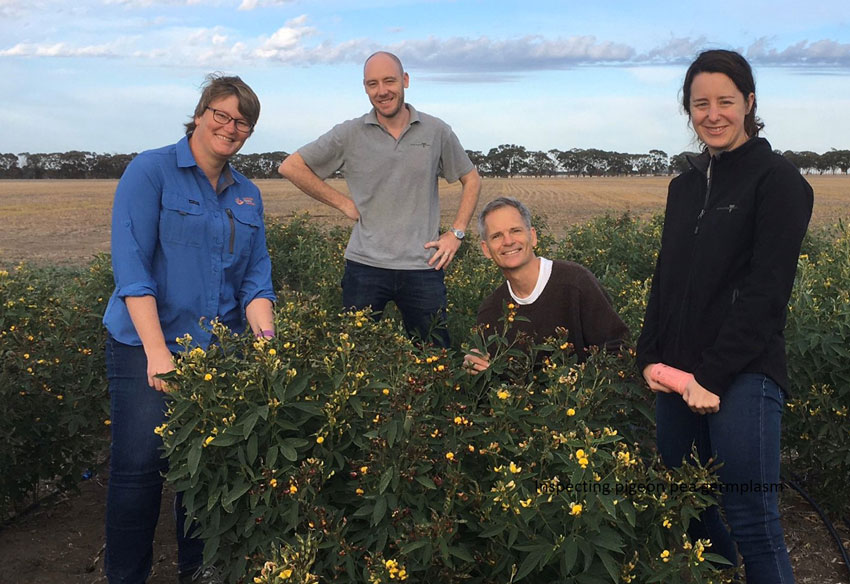Key points
- The potential value of opportunistic summer crops in Victoria has been investigated over the past four summers
- The higher-rainfall zone and irrigation areas provide better opportunities for summer grain production of soybeans, mungbeans and dry beans than the low to medium-rainfall areas
Victorian researchers are investigating the agronomic viability of a range of summer legume species that would allow growers to take advantage of sporadic summer rainfall events.
The crops under investigation include adzuki beans, cowpeas, dry beans (black, turtle, navy and pinto beans), lab lab, mungbeans, pigeon peas and soybeans – a wide-enough range of options to help growers identify opportunities for summer cropping and pick the best species for different localities.
Potential benefits include utilising summer rainfall to opportunistically grow three crops in two years, reducing reliance on artificial nitrogen, improving farm profitability and boosting Australian plant-based protein production.
This research is part of the Victorian Grains Innovation Partnership between Agriculture Victoria and GRDC.
These crops, typically grown in subtropical environments, have the advantage of an indeterminate growth habit, giving them more flexibility to maintain yield potential in the southern environment, where summer rainfall tends to be episodic.
Assessing suitability
Field trials from 2019–21 assessed the seasonal triggers needed to grow summer legumes and the suitability of current commercial species to growing environment – specifically biomass production, susceptibility to pests and diseases, grain yield and system fit (days to maturity).
The next steps included an analysis of long-term weather patterns to look at the probability of spring sowing opportunities and the amount of summer rainfall expected. In mid-2022, spatial crop models based on risk and yield will identify the most-suitable growing regions for soybeans, mungbeans and adzuki beans, which showed the most potential.
Field trials confirmed that north-east Victoria and the high-rainfall zone of the Western District – areas with more-reliable summer rainfall – have significant potential to support summer cropping. Soybeans were particularly well-suited with an average grain yield in 2020-21 of 1.7 tonnes per hectare at Hamilton and 1t/ha at Rutherglen. Yield potential under rain-fed conditions in the current summer trials (2021-22) was good.
Lab lab, cowpeas and dry beans also appear highly suitable for these environments, as either grain or high-protein fodder.
Best fit
The length of the growing season is an important factor in determining agronomic fit for each species. For example, mungbeans are considered a good fit with the Victorian winter cropping program because they are a short-duration summer crop that matures March to April.

Agriculture Victoria’s Sally Norton, Ash Wallace, James Nuttall and Audrey Delahunty are investigating the potential value of opportunistic summer legumes. Photo: Agriculture Victoria
The current summer program is focused on determining the optimal time of sowing, maturity grouping, disease risk and growth habit.
Typically, mungbeans performed well in most regions, including the Mallee (0.8t/ha), Wimmera (1t/ha), north-east (1.3t/ha) and Western District (0.5t/ha). In the Mallee and Wimmera regions yield potential relies on adequate starting soil water and/or in-season rainfall of more than 120 millimetres.
In the low and medium-rainfall zones, more-variable nature of rainfall limited the viability of summer legumes for grain production. However, they will be well-suited to irrigation districts. Preliminary assessment under irrigation at Kyabram showed high yield potential. Dry beans, navy and pinto beans yielded 2.6t/ha and 3.1t/ha respectively, compared with an average of 1.4t/ha for mungbeans in this environment.
This research has accessed a diverse supply of global landraces from the Australian Grains Genebank at Horsham in the hope of finding some landraces with growth traits better suited to Victorian growing conditions than current commercial varieties.
Ultimately, this research aims to help growers make informed decisions about the viability of summer cropping for their region. Several growers are giving them a go, although markets still need to be identified.
More information: Dr James Nuttall, 0409 423 541, james.nuttall@agriculture.vic.gov.au

























































